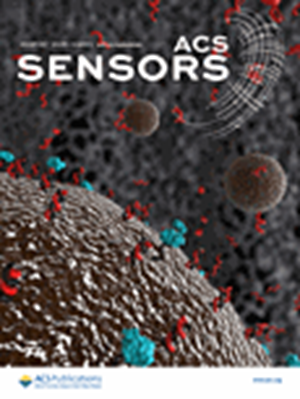Solid/Liquid/Gas Three-Phase Interface Enzymatic Reaction-Based Lactate Biosensor with Simultaneously High Sensitivity and Wide Linear Range
IF 8.2
1区 化学
Q1 CHEMISTRY, ANALYTICAL
引用次数: 0
Abstract
Electrochemical lactate biosensors with simultaneously high sensitivity and wide linear detection range are desirable for health monitoring. Nevertheless, the low oxygen level in biological fluids compromises oxidase enzymatic kinetics, which consequently results in a narrow linear detection range and/or low sensitivity. In this study, we addressed this issue by fabricating a solid/liquid/gas three-phase enzyme electrode with sufficiently high oxygen levels in the local reaction zone and much enhanced oxidase enzymatic kinetics. The three-phase enzyme electrode was fabricated by successively immobilizing H2O2 electrocatalyst and lactate oxidase (LOx) on a superhydrophobic porous carbon substrate. Owing to the much-enhanced oxidase enzymatic kinetics, the linear detection upper limit of the three-phase lactate biosensor was increased up to 40 mM, about 57-fold higher than that of the conventional two-phase system (0.7 mM), while a sensitivity as high as 22.28 μA mM–1 cm–2 was maintained. Moreover, a sweat lactate sensing device was fabricated based on the three-phase enzyme electrode and utilized for lactate detection in undiluted sweat during exercise. This three-phase enzyme electrode with both high sensitivity and wide linear range provides a new approach for the development of high-performance lactate sensing systems.

基于固/液/气三相界面酶促反应的乳酸生物传感器,同时具有高灵敏度和宽线性范围
具有高灵敏度和宽线性检测范围的电化学乳酸生物传感器是健康监测的理想选择。然而,生物流体中的低氧水平会影响氧化酶的酶促动力学,从而导致线性检测范围窄和/或灵敏度低。在这项研究中,我们通过制造一个固体/液体/气体三相酶电极来解决这个问题,该电极在局部反应区具有足够高的氧水平,并且大大增强了氧化酶的酶动力学。将H2O2电催化剂和乳酸氧化酶(LOx)依次固定在超疏水多孔碳底物上,制备了三相酶电极。由于氧化酶动力学的增强,三相乳酸生物传感器的线性检测上限提高到40 mM,比传统的两相系统(0.7 mM)提高了57倍,同时保持了22.28 μA mM - 1 cm-2的灵敏度。此外,还制作了基于三相酶电极的汗液乳酸传感装置,用于运动时未稀释汗液中的乳酸检测。这种具有高灵敏度和宽线性范围的三相酶电极为高性能乳酸传感系统的开发提供了新的途径。
本文章由计算机程序翻译,如有差异,请以英文原文为准。
求助全文
约1分钟内获得全文
求助全文
来源期刊

ACS Sensors
Chemical Engineering-Bioengineering
CiteScore
14.50
自引率
3.40%
发文量
372
期刊介绍:
ACS Sensors is a peer-reviewed research journal that focuses on the dissemination of new and original knowledge in the field of sensor science, particularly those that selectively sense chemical or biological species or processes. The journal covers a broad range of topics, including but not limited to biosensors, chemical sensors, gas sensors, intracellular sensors, single molecule sensors, cell chips, and microfluidic devices. It aims to publish articles that address conceptual advances in sensing technology applicable to various types of analytes or application papers that report on the use of existing sensing concepts in new ways or for new analytes.
 求助内容:
求助内容: 应助结果提醒方式:
应助结果提醒方式:


